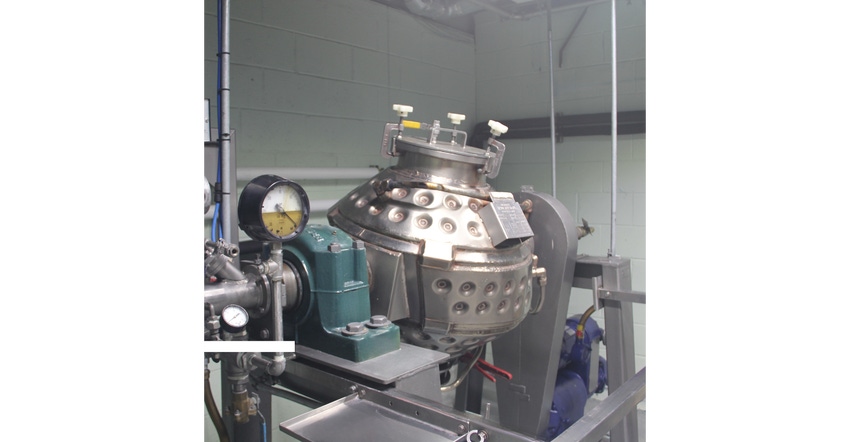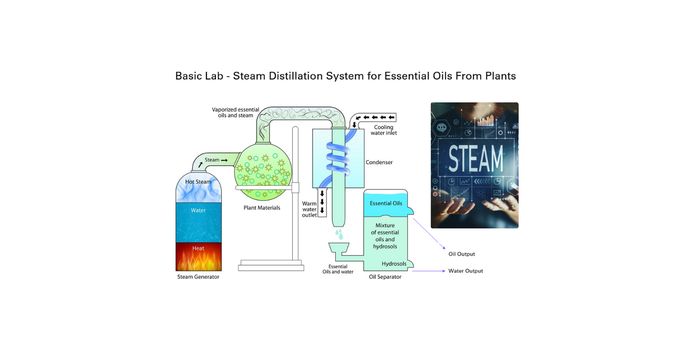Transforming Waste Tires into Sustainable Carbon Black
A unique application development for company’s formulator
November 27, 2023

GEMCO, a leading powder processing company, operating from an 80,000-cu-ft industrial machine factory, powder test and tolling center, was presented with a challenge in the tire recycling sector. The objective was to extract raw materials from discarded tires to create sustainable carbon black, a departure from conventional manufacturing methods with a significant environmental footprint.
While GEMCO's core competence lay in mixing and drying technology, the requirement to simultaneously remove water and oil posed an intricate puzzle. This case study delves into the adaptation of the GEMCO formulator to meet these requirements efficiently, ensuring a contamination-free separation process.

Steam distillation system adaptation to GEMCO formulator (image courtesy of GEMCO)
The carbon black production process necessitated the removal of water and oil from processed tire material before fine milling. The initial challenge was to devise a solution to eliminate water without disrupting the solvent recovery subsystem. This required safeguarding against potential contamination of the condenser, emulsion formation within the vacuum pump, and process piping fouling.
Drawing from GEMCO's wealth of experience--particularly in the domain of essential oils--the team capitalized on its expertise to address the unique requirements. Essential oil manufacturing equipment separates liquids, such as water and oil. This familiarity allowed GEMCO to adapt its formulator for the task without compromising the auxiliary systems.
Design Considerations
Ensuring successful separation in alignment with the project's requirements involved meticulous control over the following factors:
1. Initial Phase - Water Removal: The initial phase focused on water removal at a temperature sufficient to evaporate water under full vacuum. During this stage, the oil/water separator condenser remained uncooled to permit water vapor to pass through the system naturally.
2. Monitoring Water Removal: Water accumulation in the solvent recovery system tank served as a precise indicator of completed water removal. Automation enabled continuous monitoring of tank level and accumulation, ensuring precise control.
3. Transition to Oil Vaporization: After eliminating water, the product temperature was raised within the subject material. A slight additional water vaporization was expected due to the temperature change. Initially, the oil/water separator condenser remained uncooled, but it was later activated as the product temperature transitioned through into the oil separation phase.
4. Cooling the Separator Condenser: Starting from the point of oil vaporization, the oil/water separator condenser was cooled within the temperature range of 35-45˚F, facilitating efficient separation.
5. Oil Collection and Process Completion: Oil collection commenced at temperatures exceeding the normal vaporization temperature of the oil, with the estimated quantity ranging from 1-2% of the initial trial mass (200-300 g). The process concluded when oil collection ceased, and the laboratory mass balance indicated no significant difference between the initial and final masses.

Basic lab – steam distillation system for essential oils from plants (image courtesy of GEMCO)
Benefits and Potential Applications
By successfully adapting the formulator to meet unique requirements, GEMCO showcased its adaptability and innovation in response to customer needs. This experience opens doors to exploring other technologies and processes. For instance, GEMCO's expertise in essential oil extraction aligns with the burgeoning essential oils industry, potentially leading to transformative discoveries in various sectors.
Conclusion
Developing a novel application for the GEMCO formulator exemplifies innovation and creative problem-solving. By leveraging its extraction technology knowledge and adapting existing equipment, GEMCO effectively addressed a complex challenge. This case study underlines the power of collaboration, creativity, and the willingness to explore new applications.
Customers can leverage the company’s technical center to evaluate a variety of machines and options, thereby making informed decisions about the best equipment for their processes. This not only saves time but also optimizes resources. The facility’s precise scale-up predictions eliminate guesswork and facilitate efficient production planning.
George Paffendorf is VP of process engineering and design, GEMCO, Middlesex, NJ. For more information, call 800-654-3626, email [email protected], or visit okgemco.com.
You May Also Like


